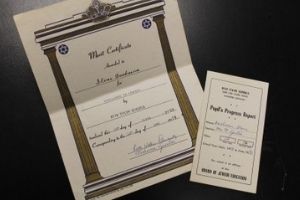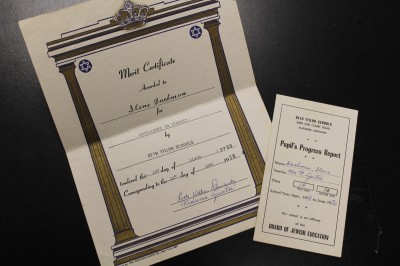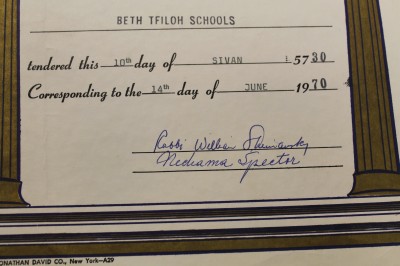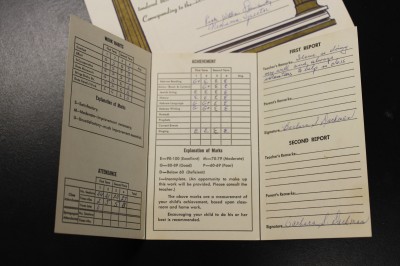The West Wing Interns’ Display Case Project: Journey to Inspiration

A blog post by Education Intern Marissa Walker. Marissa is supervised by Education Director Ilene Dackman-Alon. To read more posts by Marissa and other JMM interns, click here.
About two weeks ago, Marketing Manager Rachel Kassman gave all the interns an assignment: create a small display including collections objects, photographs, or archival documents to be displayed in the exhibition preview display case in the lobby of the museum. Interns were divided into groups of two or three and each group was given a different subject or theme to focus on in their display plans. Trillion and I were grouped together, since we are the only two interns on the West side of the museum and are working in the same department. The wide range of topics for this display project included archeology, the march on Washington, and our topic, Education.
At first, Trillion and I were a bit concerned. We were excited to participate in a project that would lead to a direct contribution to the museum’s public displays, but were overwhelmed by the enormity of our topic. Education is the focus of every parent, teacher, and student who walks through the doors of the Jewish Museum, or any museum, for that matter. We began to explore Past Perfect, our online archives and collections database, hoping to find inspiration. Thinking it might be interesting to do a study on the Hebrew day schools of Baltimore, past and present, we started with the most general search we could think of: “school.”
A few thousand search results later, we came upon an interesting collection of memorabilia from what seemed to be a camp for displaced persons in Munich, Germany. The Gaulan School was established by a couple named Nechama and Paul Spector, who had donated several of their important documents and photographs to the museum collection. Feeling confident, we tried a simple google search, hoping to find a jumping-off point for more research on the topic of the school. Although searching for Paul Spector turned up nothing in particular, Nechama’s death announcement in the Baltimore Sun gave us a few more dates around which we could make a mental timeline.
Based on our findings, we decided to pursue a display case focusing on the Spectors and their educational journey. This prompted an email to Jobi Zink, head of collections, in which we requested the transcript of Paul Spector’s oral history. Jobi obliged by not only pulling his oral history, but digging up the entire Spector collection of documents from the archives for us. Excited and filled with anticipation, Trillion and I dove (very carefully and with cloth gloves, of course) into the oral history. Although the conversational style of Paul’s oral history made it a bit difficult to follow, we did gather some important information about his life pre-WWII, which helped us put his journey into context. Feeling that we had more of a lead, we turned to the additional documents Jobi had pulled for us from the Spectors.
In the folder we found a teaching certificate for Paul Spector, and a letter of recommendation that, based on the information in his oral history, we could say with relative certainty came from the Gaulan School the year he decided to move to America (1949). We also found what seemed to be a magazine detailing the activities and happenings in the displaced persons camp in which the Spectors taught, as well as current events. Because the document was written in German and Yiddish, we recruited Education Director Ilene Dackman-Alon to help translate some of the headlines and bylines for the various articles inside. Ilene was overjoyed; the Spectors had been her Hebrew teachers when she was a child! She speculated that she might even have some of her old report cards from them, complete with Nechama’s signature.
Well on our journey to an engaging and relevant display, we are now gearing up for the last two weeks of our internship. I have learned so much this summer about every aspect of museum work. The research and collaboration that the museum workplace requires is only one small part of the knowledge I will be taking with me. This display project has been one of many great teaching tools in my museum work education, and has inspired me to continue on the path to professional museum work.



